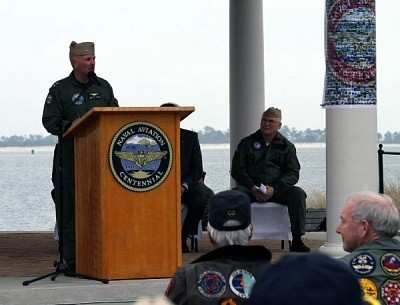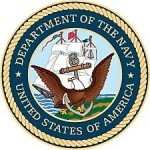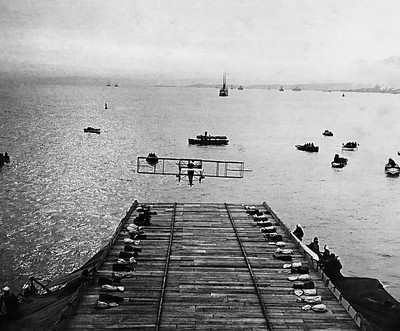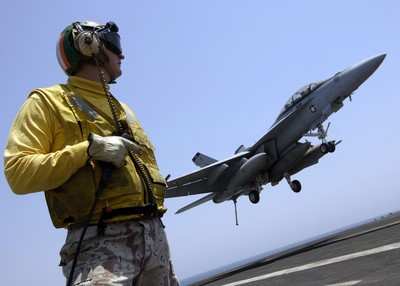Year-Long Commemoration Launched January 20
Commander, Naval Education and Training Command (NETC) helped
kick off Naval Air Station Pensacola's year-long commemoration of
the Centennial of Naval Aviation, Jan. 20. Rear Adm. Joseph
Kilkenny, NETC commander, addressed a crowd of more than 500
people.

Admiral Killkenny At Centennial Celebration
"In this year of 2011, we absolutely know how aviation
positively impacts our maritime forces, and is essential to the
defense of our republic," Kilkenny said. "That was not always the
case. In 1901 Rear Adm. George Melville wrote in the North American
Review that neither the dirigible airship nor the powered flying
machine would ever prove of any use commercially, let alone in
warfare. Rear Adm. Melville called flight 'wholly unwarranted if
not absurd.' Well nobody ever said making admiral gives you
wisdom," said Kilkenny.
Other speakers at the event included Capt. Christopher Plummer,
NAS Pensacola commanding officer, and Florida Governor Rick
Scott.
The Navy officially dates the beginning of its aviation element
to May 8, 1911, when the service's first aircraft were
requisitioned. Marine Corps Aviation dates its birth to May 22 of
the following year, when 1st Lt. Alfred A. Cunningham reported for
duty as the first Marine Corps aviator.

The date for Pensacola's kickoff was selected to coincide with
the arrival of the team who would develop the first training
program and base. "Today marks the exact day 97 years ago –
20 January 1914 - in the spot where Lt. John H. Towers and Lt.
Cmdr. Henry C. Mustin landed in Pensacola," said Plummer. "Towers
was the officer-in-charge of an aviation unit from Annapolis, Md.,
consisting of 9 officers and 23 Sailors who arrived on board the
battleship USS Mississippi (BB 23) and USS Orion (a cargo ship) to
setup a Navy flying school on these beautiful shores. Mustin was in
command of the USS Mississippi and this new Naval Air Station. This
cadre of naval officers and Sailors erected what became known as
the cradle of naval aviation. The rest is history."
Kilkenny told the audience members that as they drive around the
Pensacola region, the names of the first pioneers of naval aviation
mark the streets, building and other facilities. "Chambers Avenue,
Mustin Street, and Whiting Field," Kilkenny said. "These are but a
few of the names of our earliest aviation pioneers. The efforts of
the brave souls who took to the skies, has grown into a formidable
force. In the last 100 years, more than 337,400 men and women have
earned their wings as aviators or naval flight officers."

Curtiss Pusher Lands Aboard U.S.S.
Pennsylvania
According to Kilkenny, the people who fly aircraft are only part
of the maritime aviation story. "From the first, importance was
placed on not only training pilots, but also the critical training
of the mechanics who maintain the aircraft," Kilkenny said. "As
aviation was new, both pilots and mechanics learned 'on the fly.'
According to early flyer Lt. John Towers, 'there was no science to
flying; it was mostly trial and error.'"
The first aircraft mechanics learned by working in various shops
to watch how the wooden frames and pontoons were built, and the
fabric was stretched on the wings. The idea was to make them
jack-of-all-trades with some knowledge of motors, rigging,
blacksmithing, balloons, and how to launch and recover the aircraft
from the beach.
"Today our aircraft are among the most technologically advanced
in the world," Kilkenny said. "Their maintenance and support is
critical to the success of our maritime missions. Most of the
skilled aviation technicians are trained here in Pensacola at Naval
Air Technical Training Center, just a few hundred yards from here
at Chevalier Field. It is this exemplary training that enables our
Navy, Marine Corps and Coast Guard to successfully execute the
Maritime Strategy. And it begins here in Pensacola."
During his address, Kilkenny outlined how aviation has expanded
its abilities since the early days when aircraft were mainly used
for observation. World War II was a turning point for the naval
service as the Navy and Marine Corps battlefields came to include
the skies over contested land and sea. For the first time, naval
engagements were fought entirely in the air.

F/A-18 Landing U.S.S. Enterprise
"Today, from putting boots on the ground to placing precision
munitions on target, there are few places on the planet beyond the
reach of Naval Aviation," Kilkenny said. "This year, we celebrate
100 years of Naval Aviation. And we look forward to the next 100
years as Pensacola and the Cradle of Naval Aviation continues to
build the Global Force for Good."
 ANN's Daily Aero-Term (04.24.24): Runway Lead-in Light System
ANN's Daily Aero-Term (04.24.24): Runway Lead-in Light System ANN's Daily Aero-Linx (04.24.24)
ANN's Daily Aero-Linx (04.24.24) Aero-FAQ: Dave Juwel's Aviation Marketing Stories -- ITBOA BNITBOB
Aero-FAQ: Dave Juwel's Aviation Marketing Stories -- ITBOA BNITBOB Classic Aero-TV: Best Seat in The House -- 'Inside' The AeroShell Aerobatic Team
Classic Aero-TV: Best Seat in The House -- 'Inside' The AeroShell Aerobatic Team Airborne Affordable Flyers 04.18.24: CarbonCub UL, Fisher, Affordable Flyer Expo
Airborne Affordable Flyers 04.18.24: CarbonCub UL, Fisher, Affordable Flyer Expo






